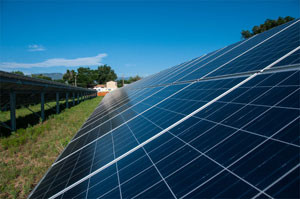November 11, 2015
Reducing utility bills by tapping into solar power is now affordable and easy
Lots of people know the value of solar energy. We may not talk about it in our casual conversations, but the benefits are obvious.
For years, many have lamented that so much beautiful, golden sunlight falls to the ground — unused and untapped — while we pay exorbitant fees for the generation of power.
Many would gladly join the solar parade if only it were affordable and participation were easy.
Recent legislation in Minnesota is turning the table on the exorbitant costs of solar power. In 2013, the state legislature enacted provisions encouraging solar energy and the creation of community solar projects. These projects are called solar gardens and they consist of rows of solar panels lined side by side. They are safe to the touch and are being built on land with good solar exposure and near existing utility distribution lines.
Solar gardens make it possible for residents to receive the benefits of low-cost solar power without paying the prohibitive upfront costs of rooftop panel installations.
Participation is easy. Residents subscribe to a community solar garden and receive a credit on their utility bill.
“The future is here,” says Karen Gados, spokesperson for SunShare, Minnesota’s largest, most experienced community solar company. “Solar technology is proven. And now you can subscribe to solar without the hassle or maintenance of a rooftop installation. Our customers see savings right away and they say it’s a no brainer.”

Because of community solar gardens, solar power is seeing an unprecedented boom in the U.S., writes Daniel Cusick in a March 2015 article posted on the Scientific American website.
“U.S. solar power grew by 6.2 gigawatts in 2014,” reports Cusick, “a 30 percent increase over the previous year and representing nearly $18 billion in new investment.”
Some of the growth, continues Cusick, is attributed to states like Minnesota that are formulating solar power incentives for residential and commercial solar use, creating a growing popularity in third-party leases offered by firms such as SunShare, SolarCity and Sunrun.
The U.S. solar industry is growing at such a rapid rate, said Rhone Resch, president and chief executive officer of the Solar Energy Industries Association, that more people are now employed in the solar industry than in tech giants Google, Apple, Facebook and Twitter combined.
“We now have 20 gigawatts of installed solar capacity — enough to power 4 million U.S. homes,” said Resch.
As solar-friendly policies are introduced in more states, and as more companies and utilities begin to offer community-owned solar power gardens, the options will grow.
An EnergySage.com article states that, “An increasing number of states are implementing policies to allow virtual net metering, which is a key policy that enables community solar programs. VNM ensures participants receive on-bill solar credits for each unit of solar power that their share of the solar garden produces — even if the panels are not located on their property.
“The amount of this credit is equal to the participant’s utility rates. For example, if someone pays 10 cents per unit (kilowatt-hour or kWh), they will receive a credit for 10 cents for each kWh of solar produced (the actual credit may vary slightly to account for transmission and distribution losses).”
The upside of subscribing to a community solar garden, continues the article, is that users will not be required to purchase a solar panel system upfront but may start saving from Day One.
“It is important for you to understand,” states the article, “how much you will pay for the solar electricity from the solar garden and how much you will save every year. … Of the available programs, fixed-rate arrangements are clearly the most beneficial for you.”
To learn how community solar gardens might benefit you, contact SunShare or calculate the impact your home can have on the environment and enroll today!
Written by Shaun Stahle and originally published on Lakeshore Weekly – Contact at:sstahle24@gmail.com
